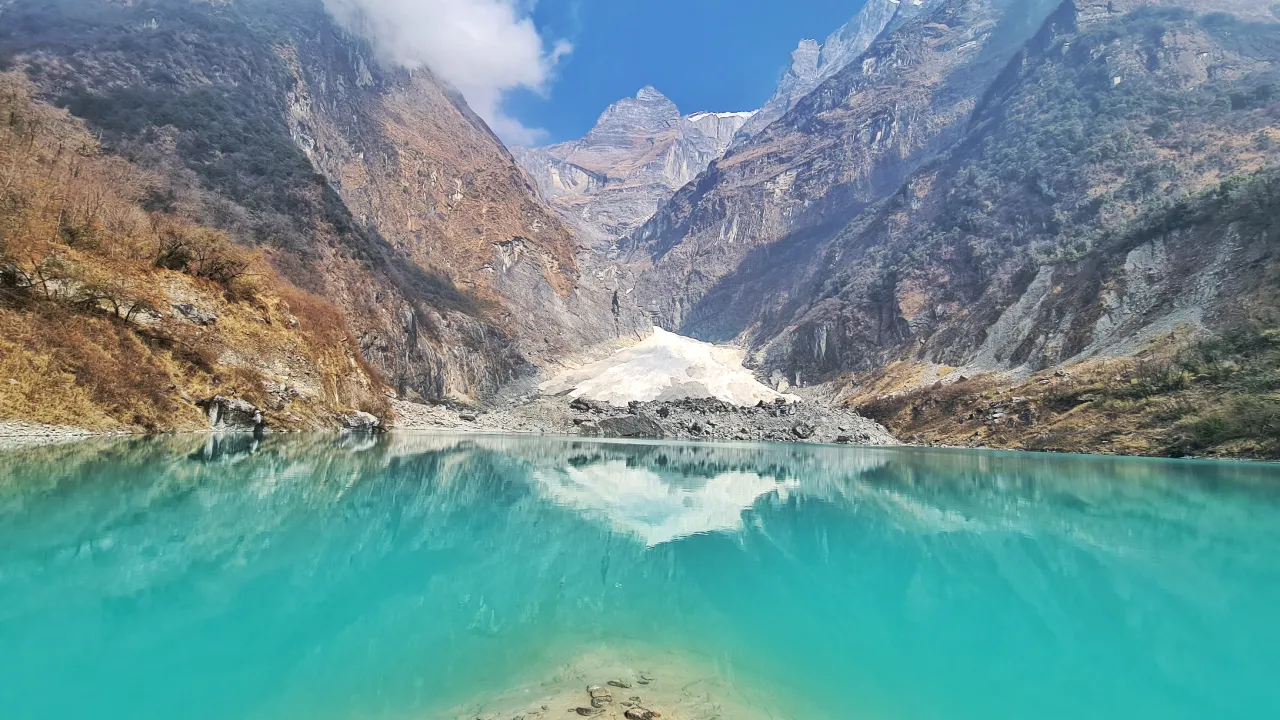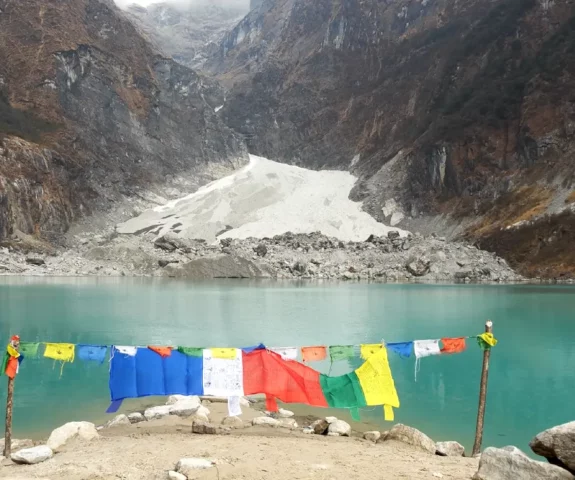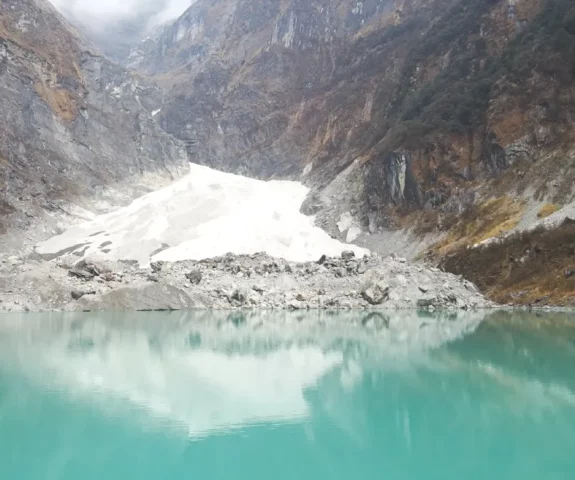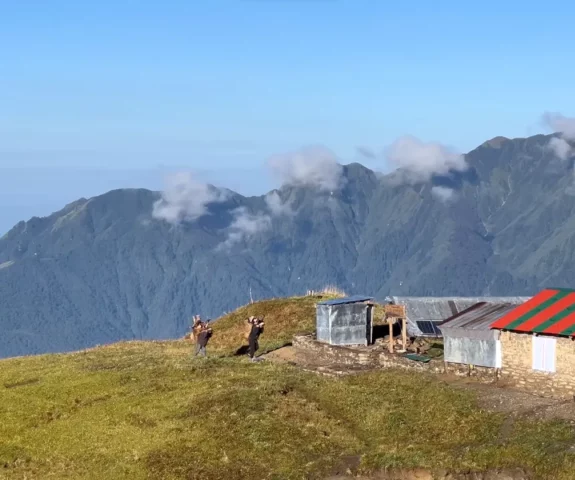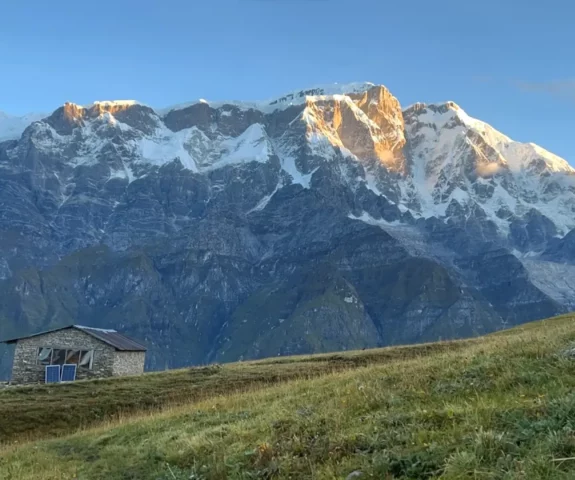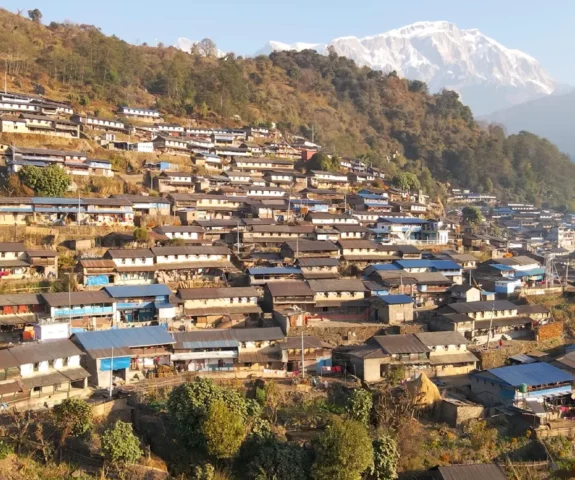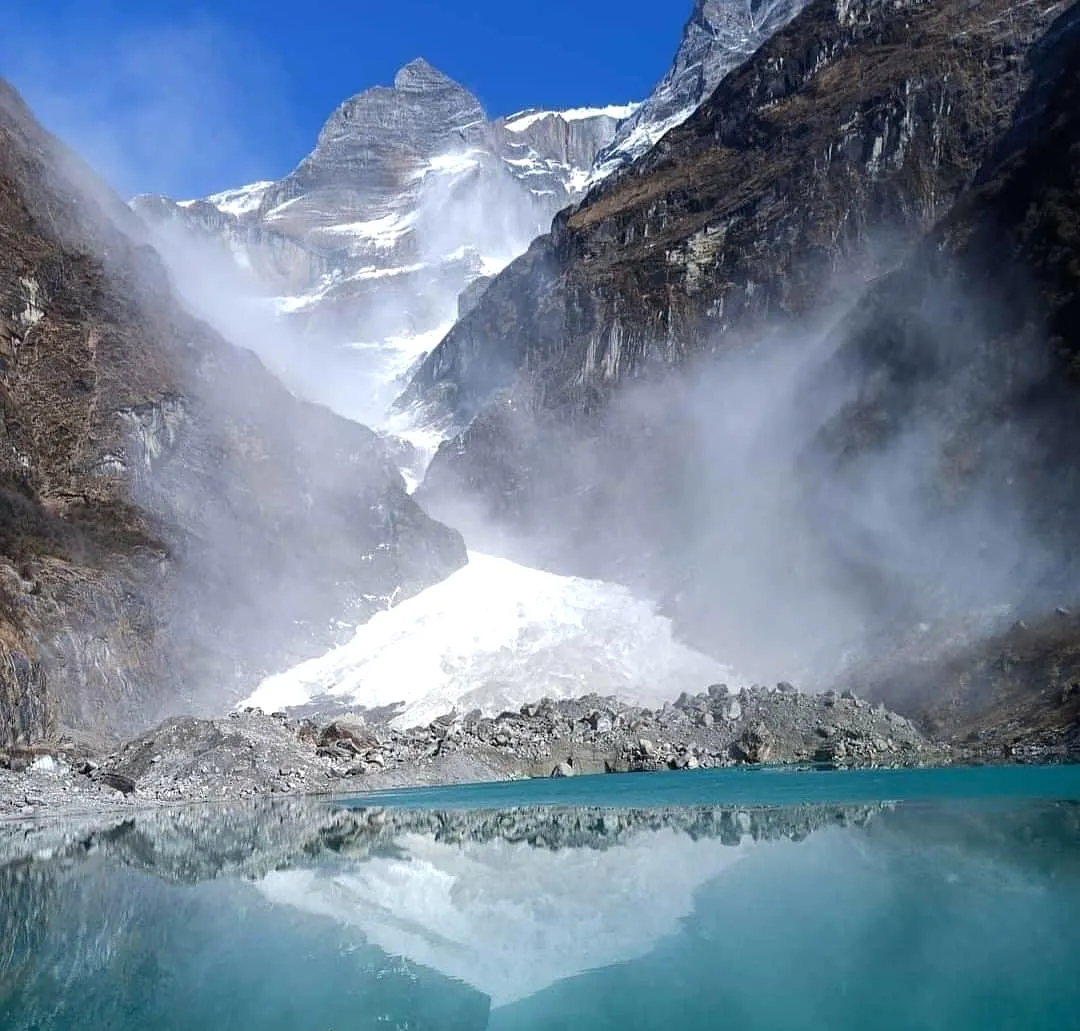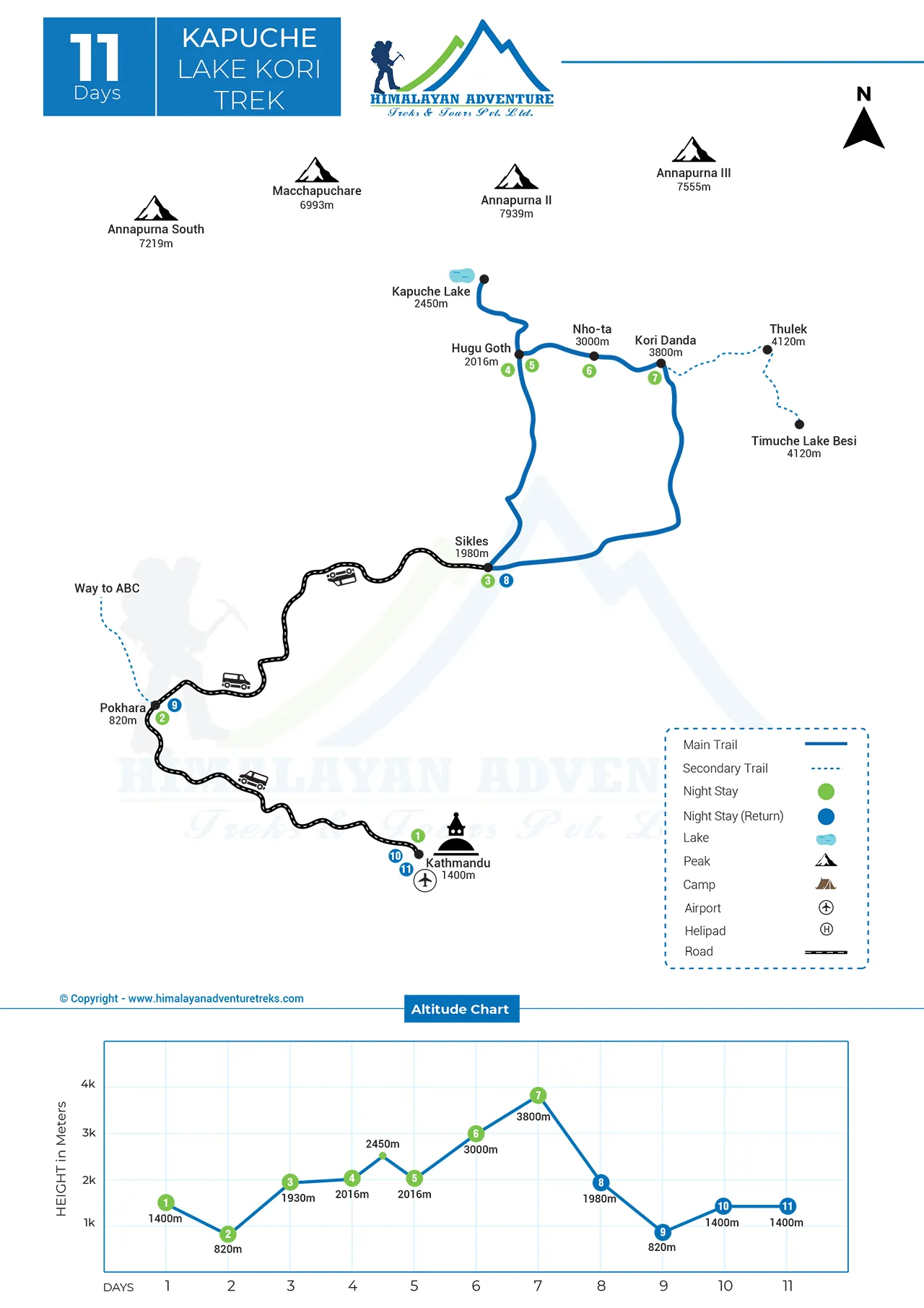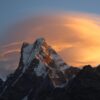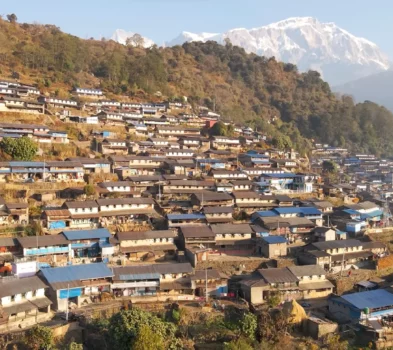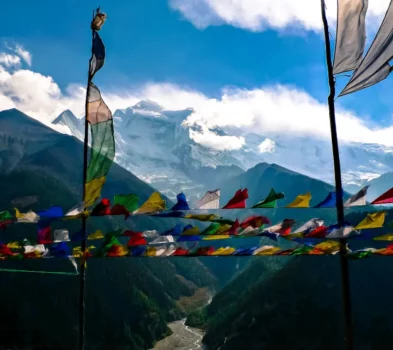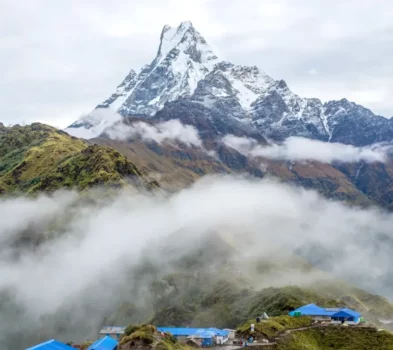Duration
11 DaysKapuche Lake Kori Trek
Trip Grade
EasyGroup Size
1-16 PeopleMax Altitude
4,115m. / 13,501ft.Best Season
Feb- May/ Sept- NovActivity
Trekking & HikingMeals
Breakfast, Lunch & DinnerAccommodation
Hotels & TeahousesTransportation
Private Vehicle & BusTrip Customization
On request (click here)Highlights of Kapuche Lake Kori Trek
- Sunrise view over Machhapuchhre from Hugu Goth ridge
- Visit Kapuche Glacier Lake’s turquoise ice at 3,210 meters
- 360-degree Himalayan panorama from Kori Danda summit
- Descending through blooming rhododendron forests in Sikles
- Watching Gurung herders move yaks along ancient trails
Trip Introduction
Himalayan Adventure Trek has come up with the Kapuche Lake Kori Trek for those who want mountains without crowds, culture without clichés, and trails still shaped by shepherds, not tour buses. You walk through the Annapurna foothills near Sikles, a Gurung village older than Nepal’s unification. Locals here speak their own dialect, wear handwoven patuka waistbands, and follow Buddhist rituals mixed with Nepalese traditions. The trail passes stone houses with slate roofs, carved woodworks, and prayer wheels spun by mountain wind.
You sleep in family-run teahouses where dinner is cooked over wood fires or kerosene stoves and stories are told in broken English and warm gestures. This Kapuche Lake Kori Trek route skirts the Modi Khola valley, feeding into the same river system that carved the famous Annapurna Sanctuary, but you avoid the permit lines and packed lodges. Kapuche Glacier Lake sits frozen half the year, sacred to locals who believe it holds the spirit of Machhapuchhre. We time your visit for late spring or early autumn, when rhododendron forests bloom in red and festivals like Lhosar or Maghe Sankranti might color village squares with masked dances and locally produced alcohol.
You meet herders from the Gurung community, moving yaks between high pastures using routes unchanged for centuries. The highest point, Kori Danda at 3,800 meters, offers unobstructed views of Dhaulagiri, Annapurna South, and Hiunchuli without a single teahouse billboard in sight. Porters from our agency carry your gear, earning fair wages and tipping you off to hidden waterfalls or medicinal plants.
You cross suspension bridges strung with prayer flags, pass chortens stacked with mani stones, and drink tea in huts where the only menu is dal bhat and the only payment is a smile. This is not Everest, nor is it Langtang; this is Nepal’s quiet backbone, where tradition still dictates the calendar, and your footprints make a positive impact on the local economy.
We handle permits, gear, meals, and surprise blisters so you focus on the Kapuche Lake Kori Trek trail. You get experienced guides, porters paid above industry rate, and teahouse bookings confirmed weeks ahead. Our Kathmandu team meets you at arrivals, checks your pack fit, and answers midnight questions. You trek to Kapuche Lake and Kori Hill with clean sleeping bags, boiled water, and emergency oxygen on standby.
Outline Itinerary of Kapuche Lake Kori Trek
Day 01: Arrival at Kathmandu Airport
Day 02: Drive from Kathmandu to Pokhara
Day 03: Drive from Pokhara to Sikles
Day 04: Trek from Sikles Village to Hugu Goth
Day 05: Trek from Hugu Goth to Kapuche Glacier Lake and return to Hugu Goth
Day 06: Trek from Hugu Goth to Nho-ta
Day 07: Trek from Nho-ta to Kori Danda
Day 08: Trek from Kori Danda down to Sikles
Day 09: Drive from Sikles to Pokhara
Day 10: Drive from Pokhara to Kathmandu
Day 11: Departure from Kathmandu Airport
Our guests sharing their experiences (Photo/Video Gallery)
Detail itinerary of Kapuche Lake Kori Trek
Day 01: Arrival at Kathmandu Airport
We land at Tribhuvan International Airport in Kathmandu after our flight touches down early or late depending on airline schedules. You clear immigration and customs in under an hour if lines move smoothly. Our local trek coordinator meets you outside baggage claim holding a sign with your name. You hop into a private vehicle for the 20-minute transfer to your hotel in or around Thamel. We check you into a three-star guesthouse with hot showers and Wi-Fi.
You rest after your long flight while we handle your permits and gear checks. We meet you at 6 PM for a welcome dinner along with the Kapuche Lake Kori Trek guide and porters. You should have a taste of momos and dal bhat as we brief you on altitude protocols and the next day’s drive. We answer your questions about trail conditions and weather forecasts for the coming week.
Activity: Airport Pickup, 30 min
Max. Altitude: 1,400m/4,593ft. Kathmandu
Accommodation: Hotel
Day 02: Drive from Kathmandu to Pokhara
We leave Kathmandu early, aiming to reach Pokhara before dusk settles. The drive covers roughly 200 kilometers. Expect the journey to consume between seven and eight hours. Road conditions vary, making the exact timing unpredictable. We navigate winding mountain roads that connect Nepal’s capital to its lakeside city. The route offers glimpses of terraced hillsides and distant peaks.
You might feel the descent as we drop from Kathmandu’s higher elevation down to Pokhara at 822 meters. Lunch stops break up the long drive, letting you stretch. Soon enough, we arrive in Pokhara, a bustling town beside Phewa Lake, ready for rest. This day is purely about transportation, moving you efficiently from the urban Kathmandu to the calmer gateway of the Annapurnas.
The road, while sometimes rough, is the standard access route before our trekking boots hit the trail near Sikles. Pokhara provides our last proper chance to stock up on any forgotten essentials. We settle into our accommodation, preparing mentally and physically for the Kapuche Lake Kori Trek ahead starting tomorrow.
Activity: Drive, 6-7 hours
Max. Altitude: 822m/2,697ft. Pokhara
Meal: Breakfast
Accommodation: Hotel
Day 03: Drive from Pokhara to Sikles
We wake up in Pokhara while the mist still hugs Phewa Lake and the surrounding hills. Breakfast fuels us for the drive day ahead. The road to Sikles climbs steadily, twisting through rhododendron forests and past remote Gurung villages. We gain over 1,100 meters in elevation, stopping at 1,981 meters by afternoon. The drive eats up about four to five hours, depending on the weather and road repairs. After parking near the entrance gate, we walk the final stretch into Sikles village.
This last leg takes roughly 20 minutes on a well-marked stone path. Stone houses with slate roofs dot the hillside, showing traditional architecture. The final stretch into Sikles reveals stone houses stacked on steep slopes. We rest in family-run teahouses with basic rooms and shared bathrooms. You refill water, air out your boots, and prep for tomorrow’s climb.
The village offers a quiet, authentic Himalayan experience before we head deeper into the Kapuche Lake Kori Trek. Locals smile and greet you with “Namaste” as you wander the single main path.
Activity: Drive, 4-5 hours
Max. Altitude: 1,981m/6,499ft. Sikles Village
Meal: Breakfast, Lunch & Dinner
Accommodation: Teahouse
Day 04: Trek from Sikles Village to Hugu Goth
Activity: Trek, 5-6 hours
Max. Altitude: 2,860m/9,383ft. Hugu Goth
Meal: Breakfast, Lunch & Dinner
Accommodation: Teahouse
Day 05: Trek from Hugu Goth to Kapuche Glacier Lake and return to Hugu Goth
On the 5th day of the Kapuche Lake Kori Trek, we leave Hugu Goth right after dawn with packed lunches and full water bottles. The trail climbs sharply through alpine scrub and across glacial moraines toward Kapuche Glacier Lake. You gain roughly 350 meters over two and a half hours of slow, steady ascent.
The path narrows in sections, hugging steep slopes with fixed ropes in icy or loose terrain. Views open wide as we rise, revealing Dhaulagiri’s massif and the glacier’s mouth feeding the turquoise lake. We reach the lake at 3,210 meters by mid-morning. Ice still dominates its edges even in late spring.
You take photos, rest on flat rocks, and eat lunch with the glacier rumbling faintly in the distance. We turn back after an hour, retracing our steps to Hugu Goth. The descent takes less time, about two hours, as gravity helps our tired legs. You check your knees, adjust your pack straps, and drink often to stay hydrated. Back at the teahouse, we wash the sweat off our faces and sip hot lemon-ginger tea.
Locals may share stories of the lake freezing solid in winter. Dinner arrives early, usually lentils, rice, some kind of veggies, and pickled radish. Following this filling meal, we will head to bed and rest well for our long descending day tomorrow.
Activity: Trek, 4-5 hours
Max. Altitude: 3,210m/10,531ft. Kapuche Glacier Lake
Meal: Breakfast, Lunch & Dinner
Accommodation: Teahouse
Day 06: Trek from Hugu Goth to Nho-ta
The following day on the Kapuche Lake Kori Trek, we pack up at Hugu Goth while the sun warms the ridge behind us. Breakfast is likely Sel Roti, some veggie stew, and black tea poured from a dented kettle. We head east along a high traverse path that skirts steep scree slopes above the Modi Khola valley. The trail undulates gently, losing a little elevation before climbing again toward Nho-ta. You walk for five to six hours, covering around 10 kilometers of rugged, remote terrain. The path is narrow in places, marked by faded cairns and yak tracks.
We cross two wooden bridges lashed together with wire, swaying slightly underfoot. Lunch happens near a shepherd’s summer camp, where you might see wool drying on rocks. Nho-ta sits at approximately 3,000 meters, a grassy plateau with stone huts used by herders in warmer months. We drop our packs inside a basic shelter with wooden floors and smoke-stained walls.
You refill water from a glacial stream using purification tablets. Dinner is simple potato stew with flatbread cooked over a wood fire. We dry socks, and check blisters, as stars appear, unobscured by city glow. You hear the occasional bell of a grazing yak nearby. We sleep wrapped in a thick blanket, listening to the pleasing sounds of the countryside.
Activity: Trek, 5-6 hours
Max. Altitude: 3,000m/9,843ft. Nho-ta
Meal: Breakfast, Lunch & Dinner
Accommodation: Teahouse
Day 07: Trek from Nho-ta to Kori Danda
Day 7 of the Kapuche Lake Kori Trek starts at around 7 in the morning. We leave Nho-ta under a bright blue sky, boots crunching on dew-holding grass. The trail climbs steeply through alpine meadows dotted with juniper shrubs. You gain 800 meters over five to six hours, pushing toward Kori Danda at 3,800 meters. The path switchbacks up a rocky moraine left by ancient ice. Your breath comes shorter as the air thins. We pause often, sipping water and adjusting layers as the sun warms our backs.
Around midday, we reach a saddle with 360-degree views of Annapurna South, Hiunchuli, and the glacier feeding Kapuche Lake far below. Lunch is a quiet scene on sun-warmed boulders, eating boiled eggs and flat bread wrapped in cloth with some tasty sides.
The final push to Kori Danda crosses a windswept ridge where prayer flags snap loudly. You might feel the altitude here; headaches are common. We chew garlic or sip coca tea if symptoms appear. Meds are also available, but things do not get that serious at this elevation.
The campsite is a flat clearing with stone windbreaks and one basic shelter. We pitch tents and our water comes from a snowmelt stream nearby. You melt snow if needed. Dinner is thick lentil soup and rice, served before dark. We check gear for tomorrow’s descent, and tape hot spots on heels. Stars dominate the overhead view, silent and sharp. You sleep early, bundled in the cozy sleeping bags you brought along.
Activity: Trek, 5-6 hours
Max. Altitude: 3,800m/12,467ft. Kori Danda
Meal: Breakfast, Lunch & Dinner
Accommodation: Teahouse
Day 08: Trek from Kori Danda down to Sikles
The next day on the Kapuche Lake Kori Trek, we break camp before sunrise, packing frozen tent pegs and stiff sleeping bags. Breakfast is quick, hot porridge gulped down while watching the first light hit Annapurna’s crown. We descend sharply from Kori Danda, losing over 1,800 meters of yesterday’s climb in one long, knee-testing drop. The trail zigzags down scree slopes and through rhododendron forests just starting to bloom in spring. You walk for seven to eight hours, covering roughly 14 kilometers of steep, rocky terrain.
Trekking poles dig into loose soil to steady each step. We stop halfway at a stone hut at 2,600 meters to drink lemon tea and rub sore muscles. Locals pass us carrying baskets of firewood strapped to their foreheads. The forest thickens as we drop, slowing down the wind and fluttering its leaves. Bird chirping replaces the glacier’s rumble. By late afternoon, we reach Sikles, greeted by the same stone houses and smiling faces from Day 3 of the Kapuche Lake Kori Trek.
You peel off boots, soak feet in a bucket of cold stream water, and change into dry socks. Dinner is celebratory, often with local buckwheat pancakes and honey. We tally blisters, share trail stories, and charge headlamps using the village’s solar panel. Sleep comes fast, deep, and dreamless after nearly 2,000 meters of descent. Your legs will thank you tomorrow.
Activity: Trek, 6-7 hours
Max. Altitude: 1,981m/6,499ft. Sikles
Meal: Breakfast, Lunch & Dinner
Accommodation: Teahouse
Day 09: Drive from Sikles to Pokhara
Activity: Drive, 4-5 hours
Max. Altitude: 822m/2,697ft. Pokhara
Meal: Breakfast & Lunch
Accommodation: Hotel
Day 10: Drive from Pokhara to Kathmandu
We wake up in Pokhara with no alarm, letting sunlight through the curtains wake us gently. Breakfast is pancakes with honey or toasted bread with jam or pancakes if you crave them. We check out by nine, loading bags into a large and comfortable tourist bus. The drive back to Kathmandu retraces the Prithvi Highway, roughly 200 kilometers of winding river valleys and roadside bazaars.
You gain elevation slowly, climbing back to Kathmandu’s 1,400 meters over seven to eight hours. We stop a couple of times, once for lunch at a trusted eatery near Mugling, and twice or so for refreshments. You can buy last-minute souvenirs, maybe prayer flags or hand-knit wool hats in Kathmandu. Traffic thickens as we near the capital. Dust, horns, and crowds replace mountain silence. We will drop you at your Kathmandu hotel in the evening.
Dinner is your choice, there are a lot of options since it’s the city area. We meet for a final debrief, hand out certificates, and share a group photo. You pack tomorrow’s airport bag, charge adapters, and set alarms. Sleep comes easily, legs heavy but heart full, knowing you walked to a culturally rich region and returned with stories and experiences that will last a lifetime.
Activity: Drive, 6-7 hours
Max. Altitude: 1,400m/4,593ft. Kathmandu
Meal: Breakfast & Dinner
Accommodation: Hotel
Day 11: Departure from Kathmandu Airport
We wake before dawn in Kathmandu and zip bags shut. You check every pocket for passports, tickets, and leftover rupees. We load into a pre-arranged taxi by seven thirty, windows down, watching the city wake up slowly. Traffic moves more slowly than expected near Kalanki, but we leave buffer time. The airport is around 20 minutes from Thamel if the roads are not too packed. We hug goodbye at the gate. The plane lifts off over the green hills you walked just days ago.
Activity: Airport drop, 30 min
Max. Altitude: 1,400m/4,593ft. Kathmandu Airport
Meal: Breakfast
Note:
If you have your own private group and want to make your trip private, we can run the custom trip all the day as per your requirements and group size.
Includes and Excludes
What are included with package?
- Pick-up from Airport and Transfer to the Hotel: Upon your arrival at the airport, a representative will greet you and transfer you to your hotel. This ensures a smooth start to your journey.
- Three Nights in a 3-Star Hotel in Kathmandu with Breakfast: You will stay in a comfortable 3-star hotel in Kathmandu for three nights, with breakfast included. This gives you time to relax and explore the capital city before your trek.
- Two Nights in a 3-Star Hotel in Pokhara with Breakfast: Similarly, you’ll stay in a 3-star hotel in Pokhara for two nights, with breakfast provided. Pokhara is a scenic city and a great place to rest and enjoy the natural beauty before your trek.
- Lunch, Dinner, and Breakfast During Trekking: Throughout the trek, you’ll be provided with three meals daily: breakfast, lunch, and dinner. These meals are served at local tea houses or homestays along the trekking route.
- Kathmandu/Pokhara/Kathmandu by Tourist Bus: Transportation between Kathmandu and Pokhara is arranged by a comfortable tourist bus, ensuring safe and scenic travel between the two cities.
- Pokhara/Sikles/Pokhara by Jeep: Travel between Pokhara and Sikles (the starting point of your trek) and back will be by jeep. This ensures faster and more convenient transport to the trekking starting point.
- Trekking Permit (ACAP): An Annapurna Conservation Area Permit (ACAP) is included, which is required for trekking in the Annapurna region. This fee helps protect the area’s natural environment and local communities.
- Trekkers’ Information Management System (TIMS) Permit: The TIMS permit is also included, which is required for all trekkers in Nepal to ensure their safety and help track trekkers in remote areas.
- All Necessary Paperwork: All the paperwork and permits necessary for your trek, including ACAP and TIMS, will be arranged and handled for you.
- All Accommodations in Homestays/Tea Houses During the Treks: Accommodation during the trek will be in local homestays or tea houses, offering an authentic experience of Nepali culture while staying in simple, cozy accommodations along the route.
- All Camping Equipment and Team Members: If your trek involves camping, all necessary camping equipment (such as tents, sleeping bags, kitchen utensils, etc.) will be provided. A full team, including cooks and helpers, will accompany you to ensure your comfort and safety.
- An Experienced, Helpful, and Friendly Guide and Porters (1 Porter for 2 Clients): A professional and licensed guide will accompany you on the trek, providing safety and cultural insights. Additionally, one porter will be provided for every two trekkers to carry your heavy bags, allowing you to focus on the trek itself.
- Kathmandu Valley Sightseeing Tours Accompanied by a Local Guide Fluent in English: Before your trek, you will have the opportunity to explore the major sights of Kathmandu with a local guide fluent in English. This includes visits to famous temples, stupas, and UNESCO World Heritage Sites such as Swayambhunath, Boudhanath, and Pashupatinath.
- Travel Rescue Arrangement: In case of an emergency, travel rescue services will be arranged. This ensures that you have support for any unexpected health or safety issues during your trek.
- Medical Supplies (First Aid Kit): A first aid kit with basic medical supplies will be available during the trek to address any minor health issues or injuries.
- All Government Taxes: All applicable government taxes related to the trek are included in the package, so you won’t have to worry about hidden charges.
- Last Night’s Farewell Dinner at an Authentic Nepalese Restaurant with a Cultural Performance: After the trek, enjoy a farewell dinner at a traditional Nepalese restaurant in Kathmandu. This dinner will include a cultural performance, allowing you to reflect on your journey and enjoy some local entertainment and food.
What are not included with package?
- Nepal Visa Fee: You can easily obtain your Nepal visa upon arrival at Kathmandu airport. The visa fee will depend on the duration of your stay.
- International Airfare to and from Kathmandu: The cost of international flights to and from Kathmandu is not included and must be arranged separately.
- Extra Night Hotel Accommodation: In case of early arrival, late departure, or early return from the mountain (due to weather or other unforeseen circumstances), extra nights in Kathmandu or Pokhara will be charged separately.
- Travel and Rescue Insurance: It is essential to have travel and rescue insurance that covers any emergency evacuations, medical expenses, and trekking-related risks.
- Personal Expenses: Any personal expenses such as phone calls, laundry, bar bills, battery recharge, extra porters, bottled or boiled water, and hot showers are not included in the package and will be borne by you during the trek.
Pick Your Suitable Date
Book a Private Trip
Private & Group Discount Price
-
1 -
1 person
US$ 1500
-
2 -
2 people
US$ 1000
-
3 -
5 people
US$ 950
-
6 -
10 people
US$ 850
-
11 + people
9999
US$ 750
Total Cost:
US$ 1500
Route Map & Altitude Chart
Kathmandu
Start/End point
Kathmandu
Trip Information
How does our trip start?
We will meet you at Kathmandu Airport with a name sign and warm tea. You skip taxi queues and head straight to a Thamel guesthouse with hot showers and charging ports. Next morning, we’ll brief you over breakfast, or the same night before bed, check gear, and hand out waterproof trail maps. Your duffel bag gets tagged, weighed, and loaded onto our Pokhara-bound vehicle. We drive through green hills and river gorges, stopping for lunch at a trusted roadside restaurant near Mugling.
You arrive in Pokhara by dusk, check into a lakeside room, and attend a short prep talk with your guide. Dinner is optional, solo or group. You sleep relaxingly, wake early, and board the mountain road by seven.
Difficulty
You climb 1,100 meters in one day to reach Sikles. You walk six to eight hours daily on uneven stone, scree, and forest paths. Altitude reaches 3,800 meters at Kori Danda, where headaches and short breaths test your pace. Trails narrow near Kapuche Lake, requiring balance and focus. Descents pound knees, especially Day 8’s 1,800-meter drop. You carry only a daypack. Porters handle the rest.
We build in rest stops, acclimatization options, and flexible turnarounds. No technical gear needed or ropes, you just need strong boots, trekking poles, and mental grit. Beginners with training finish it exhausted while veterans call it satisfyingly raw.
Best seasons
We run this trek between late March and early June, then again from late September to mid-November. You walk under clear skies with daytime temperatures between 10 and 20 degrees Celsius at lower elevations. Rhododendron forests bloom crimson in April. Autumn offers sharper mountain views and stable trails after monsoon greenery fades. You avoid December to February when Kapuche Lake freezes solid and Kori Danda gets buried under snow. Monsoon months bring landslides on the road to Sikles and leeches on lower trails.
We track the weather daily using data from credible sources. You get updated packing lists based on seasonal forecasts. Local guides adjust start times to dodge afternoon winds on ridges. We never push summit days if snow falls above 3,500 meters. Your safety overrides the schedule every time.
Can a beginner join this trip?
It is not mandatory to have prior high-altitude experience, but it is surely beneficial, since you must walk five to seven hours daily for five days. We train first-timers with pre-trek cardio plans and stair workouts. Our guides pace the group for gradual acclimatization, inserting rest stops and hydration checks. You sleep no higher than 3,800 meters, well below dangerous altitude thresholds. We provide oxygen, first aid, and daily health checks.
Beginners finish this trek every season when they follow our prep advice. You must be injury-free and able to climb stairs without stopping. We offer training hikes in the Kathmandu Valley if you arrive early. No one gets left behind.
Altitude Sickness
We monitor your pulse and breath rate each morning above 2,500 meters. You drink three liters of water daily and avoid alcohol, caffeine, and heavy meals. We build short acclimatization rests into the itinerary, adding rest steps at Hugu Goth and slow climbs to Kori Danda. Symptoms like headache, nausea, or dizziness trigger immediate action. We carry Diamox, oxygen canisters, and descent plans for every high camp.
You learn to recognize early signs during our pre-Kapuche Lake Kori Trek briefing. We never rush summit days. We descend back if your oxygen saturation drops below 85 percent. Locals chew garlic or sip ginger-honey tea to ease symptoms. We check in twice daily above 3,000 meters. If needed, we arrange a helicopter evacuation through our partner in Pokhara.
Accommodation, Food and Drink
We book family-run teahouses with wooden sleeping platforms and shared squat toilets. You sleep under thick wool blankets, sometimes with a hot water bottle in winter. Meals are cooked over wood or kerosene stoves. Dal bhat appears twice daily, served with pickles, lentils, rice, and optional eggs or cheese. You refill water from boiled sources or use purification tablets we provide. Tea comes with every meal, often spiced with ginger or lemon.
In Sikles and Pokhara, you choose from local menus, including momos, thukpa, or pancakes. We avoid canned drinks. We carry emergency snacks like nuts and chocolate for summit days. You wash your face and feet in buckets of cold stream water. Solar panels power lights until nine. No showers available at Hugu Goth unless pre-booked. You eat what locals eat and sleep where locals sleep.
Transportation
We pick you up at Kathmandu Airport in a private, insured vehicle with AC and extra legroom. You ride in a sturdy Tata Sumo or Mahindra Scorpio for most road transfers, driven by guides who know every pothole between Pokhara and Sikles. We leave buffer time for landslides during the monsoon or fog delays in winter, in case you want to do the Kapuche Lake Kori Trek in the off-season. Your gear travels in waterproof duffels strapped to the roof with Nepali rope knots that seldom slip. We schedule lunch stops at clean roadside eateries near Mugling and Dumre, not tourist attractions.
You never have to haggle with taxi drivers or wait at bus stations. We track your location and adjust pickup times if your flight lands late. All vehicles carry first aid, oxygen, and satellite comms for mountain sections.
Permit
We secure your Annapurna Conservation Area Permit and TIMS card before you land in Kathmandu. You submit passport scans online, and we handle the rest. No queues at Nepal Tourism Board and absolutely no last-minute paperwork in Thamel. We verify all names match your passport exactly to avoid checkpoint rejections. Your permit includes mandatory conservation fees that fund trail repairs and village schools near Sikles.
We print two copies, one for your guide, one for your daypack. We update permits if you extend your trek or change routes. Fees are included in your package, no hidden charges at entry gates. You walk through checkpoints with a wave, not a wait.
Trip preparation and fitness
You train with weighted walks on hills or stairs for a minimum of six weeks. We suggest breaking in boots on rocky trails before arrival. Carry poles reduce knee strain on 1,800-meter descents. Hydration and electrolyte discipline prevent headaches above 3,000 meters. Pack blister tape, zinc oxide, and ibuprofen in your daypack. We provide gear checklists, altitude guidelines, and daily distance maps. Eat carb-heavy meals during training. Sleep seven hours minimum and do not engage in last-minute gym heroics.
Cost & Budget
We price this trek at USD _____ per person including permits, guides, meals, and transfers. Budget about US _____ extra for tips, souvenirs, and airport snacks. Teahouse upgrades add USD 20 per day for extra services like laundry, Wi-Fi, etc. Gear rental runs about $60 for jacket, bag, and poles. Flights and visas cost separately. We accept cash payments in rupees or USD. We highly recommend trekkers keep small bills for village purchases.
Gadgets charging & Internet
We provide solar-powered charging at most teahouses, but the output depends on the number of sun hours. You get one free charge per night for phones or headlamps. Power banks under 20,000mAh work best. The Internet is absent above Sikles. No Wi-Fi, and very weak mobile data. We carry satellite messengers for emergencies only. You can charge before dinner or on the go if you bring along a power bank.
Your Extra expenses
You pay for bottled water, snacks, alcohol, tips, and souvenirs. Budget 1800 to 2200 NPR per day. Hot showers cost 100 NPR if solar tanks are full. SIM cards bought in Kathmandu won’t work that well on the Kapuche Lake Kori Trek since the villages are too remote. Keep small bills for tea stops. Tipping guides and porters at the end of the trek is optional but very appreciated.
Things to Remember Before Trekking The Kapuche Lake Kori Trek
- Pack broken-in boots, not new ones. Blisters ruin summit views and silent mornings above the tree line.
- Carry water purification tablets always. Glacier streams look clean but carry Giardia that knocks you off the trail.
- Wear moisture-wicking base layers daily. Cotton traps sweat, chills you fast when the wind hits exposed ridges at dawn.
- Label all gear with your name. Porters move fast, bags look alike, and lost gloves freeze fingers at 3,800 meters.
- Start hydrating heavily in Kathmandu. Altitude creeps up slowly, and dehydration hits hard before you feel short of breath.
- Keep small Nepali rupee notes handy. Village stalls don’t break 500s, and tea costs 50 before the big climb.
- Pack blister tape and zinc oxide. Knees survive descents, feet survive only if you tape hot spots before pain starts.
- Respect local customs, ask before photographing. Prayer wheels spin clockwise, shoes off in homes, silence near chortens matters deeply.
Essential Packing Gear List for Kapuche Lake Kori Trek
If you have decided to go on the Kapuche Lake Kori Trek in Nepal, we assure you that you will have a fantastic time ahead. But what should you pack for your Adventure? What will be the right gear to make your trip more fabulous? To help you with this, we have compiled a packing list of essential items that you mustn’t forget to bring along.
- Passport ( min 6 months valid)
- Cash, credit card
- List of important addresses and contact details
- 2-3 passport photos (optional)
- Copies of all important travel documents (passport, visa, airline ticket, insurance policy, etc.)
- A sturdy 70 L trekking backpack which will be carried by your porter (please note that our assigned 1 porter will carry 2 clients’ luggage up to 20-25 kg.
Note: We will provide each participant with a spacious 70 to 75 L Company logo duffle bag to conveniently carry your trekking gear, which you have to return once the trek is complete. - A 30 L Daypack that has room for your essentials such as camera, mobile, Passport, important documents, water bottle, day use medicine, chocolate bars, raincoat, etc., which will be carried by you.
- Protective cover for a backpack or travel bag.
- Hiking Boots: Preferably ankle-high boots to prevent ankle sprain
- Regular Shoes: For small strolls and exploration around the city
- Second, a light pair of shoes and possibly sandals
- Micro Spikes or Ice Cleats for the winter trekking over snow and ice
- Gaiter for added protection in snow
- A rain and wind-resistant, lightweight down jacket for warmth, with a good helmet hood
- Summer-light, as well as winter warm clothing
- Quick-drying shirts made of synthetic fabrics
- Warm and cool vests or T-shirts
- Functional synthetic underwear
- Sports Bra for Female Trekker
- A waterproof pair of trousers
- Regular trousers of quick-drying fabric
- Hiking shorts
- Cargo Pants with multiple pockets to hold your small items, such as knives or chocolates
- Woolen or fleece pants
- Trekking socks, both thick and woolen fabric, and lighter wool socks
- Wool hat, gloves, and scarf
- A light cotton scarf or a bandanna for protection of your head, neck, ears, and mouth
- Sun hat, and sunglasses with 100% UV protection (for trekking trips, even with stray light and nose protection)
- Sunscreen cream or lotion with a high sun protection factor (at least 15, for trekking trip,s even at least 30)
- Sunscreen lipstick with a high SPF (at least 20, for trekking trips, even at least 30 or sunblock)
- Mosquito repellent (Optional)
- Comfortable light night clothes and shoes
- A drinking bottle that can be used as a hot water bottle on frosty nights
- Flip-flops or bathing shoes for using the showers
- Water purifiers: if you need to refill water from the tap or stream en route
- Headlamp: for a midnight or pre-dawn trip towards the viewpoint
- Quick-drying towel and sample-size toiletries for washing your feet and face
- Your Personal first-aid kit: with basic medical supplies such as bandages for sprains, antidiarrheal and antibiotics, iodine wipes for scrapes and cuts, plasters, aspirin, or ibuprofen, moleskine for preventing blisters, Diamox (acclimatizing medicine), and your Personal medication
- Sleeping bag appropriate for all-season treks (we can hire in Kathmandu)
- Waterproof money belt, chest bag, leg bag, or belt bag for storing important travel documents or valuables
- Toothpaste, Toothbrush, and soap
- Deodorants
- Moisturizer
- Nail clippers
- Feminine hygiene products (Sanitary Pads)
- Small mirror
- Wet wipes
- Hand sanitizer
- Comb
- Camera with sufficient memory cards and spare batteries, or a battery charger
- Small padlock for your travel bag
- Thermos flask
- Water bag
- Toilet paper (2-3 rolls without)
- Ear Plugs
- Matchbox, or lighter
- Compass or GPS
- Map
- Alarm clock
- Multi-tool kit
- Binoculars
- Books
- Whistle
Equipment Note:
- Please note that there is no need for you to bring all these heavy items, such as a Sleeping bag, a down Jacket, Trekking Poles, and items from your home. You can easily rent or purchase high-quality to standard-quality items in the Kathmandu Thamel area and Pokhara.
- Items are available from international brands such as The North Face, Sherpa Adventure, Marmot, Mountain Hardware, Black Yak, Karma Gear, and local brands like Goldstar and locally made products etc.
- Plus, we will also gift you a company logo T-shirt as a token of your experience in Nepal with us.
Renting Cost:
- Sleeping Bag & Down Jacket (-10-20 degree Celsius), Per Piece per day US$ 1.5
Frequently Asked Questions
Can I pay for extra garlic soup in Sikles with US dollars or only NPR?
You must pay in Nepali rupees. Teahouses in Sikles do not accept US dollars or foreign currency. Small bills under 500 NPR work the best. Keep 1500 to 2000 NPR per day for extras like garlic soup, boiled eggs, bottled water, and other extra expenses. We advise exchanging money in Pokhara or Kathmandu before the Kapuche Lake Kori Trek. ATMs do not exist in Sikles.
Guides carry small emergency cash but cannot break large notes. Receipts are handwritten on scrap paper; no digital payments or card readers are available. Having the exact change can be very convenient. Keep coins in a ziplock to avoid losing them in your pack.
Does the celebration dinner include vegetarian Newari options or just meat thali?
We serve a full vegetarian Newari dinner set alongside meat options. You get bara, chatamari, yomari, lentil soup, beaten rice, and pickled greens. Cooks prepare veg meals separately using dedicated pots and utensils. We confirm your preference during booking and remind the kitchen staff the day before. No cross-contamination and absolutely no upcharge for this arrangement.
If you follow strict no-onion-garlic rules, we can adjust further. Just tell us in advance. Portions are generous and seconds are free. Dessert is jujube pudding or rice flour dumplings, or something like Gulabjamun. Live musicians play traditional instruments and songs of village love and country, in fully traditional attire while you eat.
Will the guide wake me before dawn if I want photos at Kori Danda?
We set two alarms for you if you want sunrise shots at Kori Danda. Your guide knocks on your door at 4:45 AM with hot lemon tea and a headlamp. They carry spare batteries and help you find the best vantage point above camp. They wait with you until the first light hits the hills and peaks nearby. You get time to frame shots without rushing.
They carry a thermos for refills and point out cloud movement for better composition. If you feel dizzy or cold, they walk you back slowly. We do this for every guest who asks with no extra fee. Just tell us the night before.
What are the major risks of the Kapuche Lake Kori Trek, if there are any?
You might face altitude sickness above 3,000 meters, especially if you rush to Kori Danda. We monitor symptoms, carry oximeters, and descend immediately if your oxygen dips below 85. Trail risks include loose scree near glacier moraines, icy patches on the Kapuche approach, and narrow ridges with exposure. The weather shifts fast and snow falls even in May above 3,500 meters. We pack emergency sacks and reroute if storms hit.
Is there a weight limit for rented gear if I add a down jacket last minute?
We rent jackets under 1.2 kilograms. Sleeping bags weigh about 1.5 kilograms, and poles are 300 grams. Total rented gear must stay under 8 or 9 kilograms since you will also have other items to pack. We subtract weight from your duffel allowance or charge you extra if it’s over the limit. Porters carry 12 kilograms max per client. Exceed that, and you pay for the exceeded amount separately. We weigh everything in Kathmandu; no exceptions.
Can I leave my passport in Pokhara and carry only a photocopy uphill?
You may leave your original passport in the hotel safe in Pokhara. We lock it in a fireproof box with a digital log. You carry a notarized color photocopy with a visa and an entry stamp. Guides hold a backup set in waterproof sleeves. No checkpoint between Sikles and Kori Danda requires originals. Immigration only checks at Kathmandu Airport.
We recommend keeping one emergency contact and insurance details on the copy. Lost passports delay flights, not treks. If you prefer to carry it, use a neck pouch under layers. We’ve never had an issue with copies on this route.
Will my 65L duffel fit in the jeep if I add the Pokhara upgrade?
Your 65L duffel fits if we use our extended Mahindra Scorpio with fold-flat rear seats. We strap it upright behind the back passenger seat. You ride with a daypack at your feet. We measure every bag at Kathmandu pickup.
If yours exceeds the trunk space, we assign a larger vehicle at no extra cost. Roof racks can also be used in such cases, provided that they are unused. We photograph your bag and tag it with your name and room number. Jeeps depart clean, fueled, and pre-checked for suspension and tire pressure.
Are prayer flags along the trail replaced seasonally or left to fade naturally?
We walk past prayer flags tied by pilgrims, monks, and locals over decades. Most fade naturally under sun, wind, and monsoon until threads unravel. Replacement happens during festivals like Lhosar, Sonam Lhosar, or Buddha Jayanti, not on a fixed schedule. You may see fresh strings near chortens or high passes where communities gather annually. We encourage you to tie new flags only at designated spots with permission.
Locals sell blessed sets in Sikles or Pokhara. Never step over or discard old flags. We carry spare rolls for group ceremonies at Kori Danda. Colors represent elements. Their fading carries prayers skyward.
Can I request no onion or garlic in meals for cultural or dietary reasons?
You can request no onion or garlic at booking. We note it in your file and alert every teahouse chef from Sikles to Kori Danda. Cooks substitute with ginger, tomato, radish, or local timmur spice. Meals stay flavorful regardless of the lack of onion and garlic. We double-check at each stop. Bring your own spice if you prefer. We recommend trekkers confirm again when they arrive at each lodge.
We provide laminated dietary cards in Nepali for kitchen staff, free of cost. Cross-contamination is rare in small kitchens; you can eat safely and rest assured. We’ve handled Jain, Hindu Vaishnav, and medical diets for years. Just tell us early.
Is the Kapuche Lake Kori Trek fit for first-timers?
You climb to 3,800 meters on uneven, remote trails with no road access or quick exits. First-timers often underestimate the descent from Kori Danda, which pounds their knees for hours. Teahouses lack heating, Wi-Fi, and western toilets are not appealing to most. Weather shifts fast above the tree line. We’ve seen fit beginners succeed, but only with solid cardio, broken-in boots, and mental readiness for basic conditions.
If this is your first trek, try Ghorepani Poon Hill or Langtang Valley first, build stamina, and test gear. Learn how your body reacts above 3,000 meters. Then return to Kapuche. However, we offer a training program for first-time trekkers; for this, you have to arrive almost 7 weeks before the start of the Kapuche Lake Kori Trek.
Is the satellite phone available for personal calls or emergencies only?
We issue the satellite phone for emergencies only. You may send one pre-approved text message per day if the family requires urgent updates. Personal calls, social media, or streaming are not permitted, and frankly, not a possibility as well. Battery life lasts roughly 72 hours under normal use. We log every transmission for safety and accountability. Guides carry the device and decide when usage is justified. If you need regular contact, buy a local SIM in Kathmandu, though coverage vanishes past Sikles.
We train all guides in emergency protocols. The phone connects directly to the Himalayan Rescue Association and our Kathmandu center. This is not a luxury, it is a lifeline.
Will the guide carry Diamox or must I bring my own altitude tablets?
Yes, the guides carry Diamox, but you must also bring your own supply prescribed by your doctor. Our guides carry basic first aid, oxygen, and altitude sickness protocol sheets. They monitor your pulse, sleep, and hydration. If symptoms appear above 3,000 meters, we descend immediately. Diamox does not require prior medical consultation. Pharmacies in Kathmandu sell it over the counter, but we recommend bringing your verified batch.
Start taking it 24 hours before ascent if advised. We track your dosage if you share your plan. You should keep tablets dry and labeled.
Is the wooden bridge near Lekh village safe for someone scared of heights?
The bridge is safe but exposed. It spans twenty meters over a rocky stream, suspended by steel cables and wooden planks. Locals cross daily with livestock and loads. You feel it sway slightly. Handrails are waist-high and sturdy. We walk first, you follow at your own pace; there is no need to rush. Some trekkers count their steps while others close their eyes and hold hands with fellow trekkers.
There is no judgment in such cases. If panic hits, you should not shy away from things. An alternative route is also available, this path adds thirty minutes but avoids the bridge entirely.
Can I swap the lunches for packed trail meals to save time climbing?
You can swap any lunch for a packed meal if you notify us before 7 PM the night before. We prepare boiled eggs, chapati, local cheese, nuts, and dried fruit wrapped in cloth. No plastic, since we promote sustainable trekking. You eat while walking or at scenic rest points above the tree line. This saves 45 to 60 minutes on summit days like Kori Danda or Kapuche Lake. You can carry extra snacks in case you need more.
We adjust water refill stops to match your pace. Just tell your guide at dinner. We log it in the kitchen book. Locals appreciate fewer lunch crowds at their stone huts.
What side of the local Gurung community can I see on this Kapuche Lake Kori Trek?
You walk through Sikles, a Gurung village preserving and showcasing the declining practices of Gurung culture. Locals wear traditional patuka and speak their own dialect and language. You see women weaving wool on backstrap looms and men repairing slate roofs with hand-forged tools. Kids walk two hours to school carrying books in dusty bags. Families invite you for tea in homes made of wood, stones, and clay, and smoke-blackened kitchens.
Elders share stories of life when yaks carried salt from Tibet. You witness ancient rituals at chortens and Buddhist prayers at hidden shrines. We time visits to avoid staged performances.
Are visa fees and permit fees included in the Kapuche Lake Kori Trek?
Permit fees are fully included. We secure your Annapurna Conservation Area Permit and Trekkers’ Information Management System card before Day 3. You just show your passport, and we handle the rest. However, visa fees are not included. You pay those separately at Kathmandu Airport. Tourist visas cost 30 USD for 15 days, 50 USD for 30 days.
We recommend travelers bring exact cash. We remind you at booking to keep your visa receipt. Immigration checks it on exit. We reimburse nothing if you overstay. Double-check your passport has six months’ validity.

